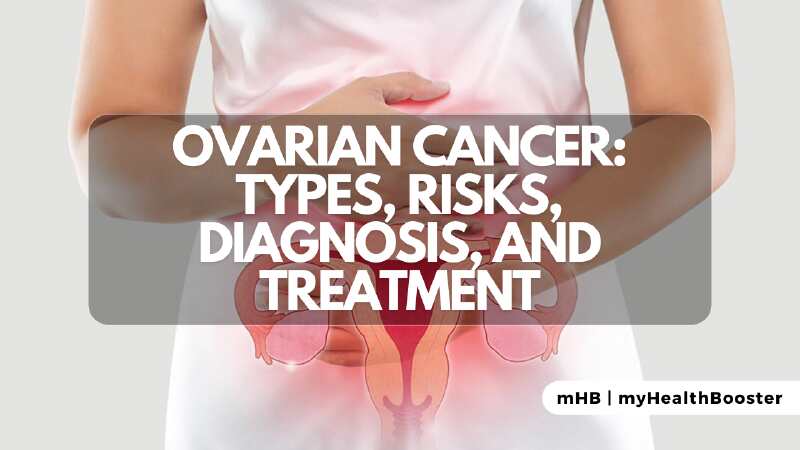Ovarian cancer encompasses a spectrum of diseases originating from cells of the ovaries, including epithelial, germ cell, and stromal tumors. This article provides an in-depth exploration of ovarian cancer, covering its types, risk factors, diagnosis, treatment, and the emotional aspects of coping with the diagnosis.
Types of Ovarian Cancer
- Epithelial Ovarian Cancer (EOC): Representing 85%-90% of cases, EOC includes serous, mucinous, clear cell, and endometrioid subtypes. These cancers often arise from DNA changes in cells, with the serous subtype being the most prevalent.
- Ovarian Tumors of Low Malignant Potential (OLMPT): Accounting for 15% of EOC, OLMPT, or borderline tumors, are less aggressive and have a lower tendency to metastasize. Removal of the tumor can often result in a cure.
- Germ Cell Tumors: Uncommon and typically found in teens or young women, germ cell tumors have various subtypes. They arise from reproductive cells and are treated differently based on the specific subtype.
- Stromal Ovarian Cancers: Arising from supporting tissues within the ovary, stromal tumors, including granulosa-stromal and Sertoli-Leydig cell tumors, are less common than epithelial tumors.
Ovarian Cancer Risk Factors
- Menstrual cycles and ovulation history significantly impact risk.
- Family history, especially the presence of BRCA1 and BRCA2 mutations, elevates the risk.
- Lynch syndrome, Li-Fraumeni syndrome, and Cowden’s syndrome are associated with increased ovarian cancer risk.
- Birth control use for over 10 years and tubal ligation decrease ovarian cancer risk.
Ovarian Cancer Statistics
- Over 22,000 cases and almost 14,000 deaths annually in the U.S.
- Epithelial ovarian cancer is often diagnosed at advanced stages, impacting survival rates.
- Survival rates vary by cancer type and stage, with localized tumors having higher survival rates.
Diagnosing Ovarian Cancer
- Vague symptoms include fatigue, abdominal swelling, changes in bowel habits, and shortness of breath.
- There are no effective screening tests; diagnosis relies on imaging, blood tests (CA-125, HE4), and often surgical biopsy for confirmation.
Ovarian Cancer Treatment
- Surgical Treatment: Staging and debulking surgeries involve removing affected tissues, and optimal debulking aims to eliminate all visible disease.
- Chemotherapy: Platinum and taxane drugs are commonly used, either intravenously or intraperitoneally. Targeted therapies like bevacizumab and PARP inhibitors are also employed.
- Experimental Treatments: Clinical trials explore new treatments, and immunotherapy shows promise in enhancing the immune system’s response to cancer.
Ovarian Cancer Staging
- Stages range from localized (Stage 1) to distant metastasis (Stage 4), impacting treatment decisions.
- Complete staging involves surgeries to assess the extent of cancer spread.
Survival Rates and Prognosis
- Epithelial ovarian cancer has a high mortality rate, but survival has improved with optimal debulking and intraperitoneal chemotherapy.
- Germ cell and stromal tumors generally have better prognoses.
Preventing Ovarian Cancer
- No foolproof prevention, but long-term birth control use and tubal ligation reduce risk.
- Removal of fallopian tubes or ovaries may be considered for high-risk individuals with genetic mutations.
Coping with Ovarian Cancer
- Emotional support, counseling, and participation in support groups are crucial.
- Organizations like the American Cancer Society, and National Ovarian Cancer Coalition offer resources and coping strategies.
Summary
Ovarian cancer presents complex challenges, requiring a comprehensive understanding of its types, risks, diagnosis, and treatment. While advancements in treatments have improved survival rates, ongoing research, and support remain vital in the collective effort to manage and eventually conquer ovarian cancer.
References
- American Cancer Society. “Hormone Therapy for Ovarian Cancer.” April 11, 2020.
- Ethier, Josee-Lyne, et al. “Survival outcomes in patients with platinum-resistant (PL-R) ovarian cancer (OC): The Princess Margaret Cancer Centre (PM) experience.” Journal of Clinical Oncology 35, no. 15_suppl May 30, 2017.
- Green, Andrew. “Ovarian cancer.” Medscape. Jan. 5, 2018.
- “Ovarian, Fallopian Tube, and Primary Peritoneal Cancer — Health Professional Version.” National Cancer Institute.
- United States. National Cancer Institute. “Ovarian, Fallopian Tube, and Primary Peritoneal Cancer Prevention (PDQ®)–Patient Version.” March 27, 2019.
- United States. WomensHealth.gov. “Ovarian Cysts.” April 1, 2019.
